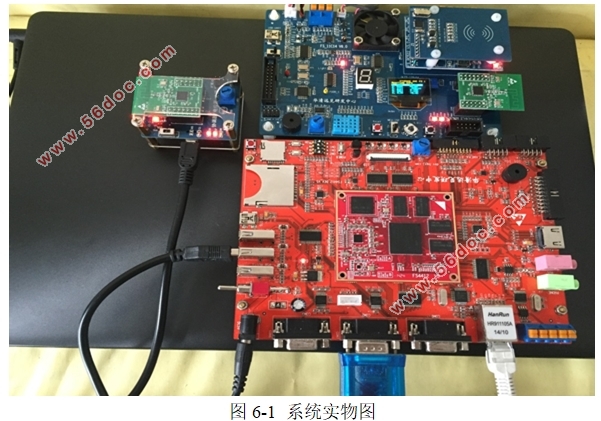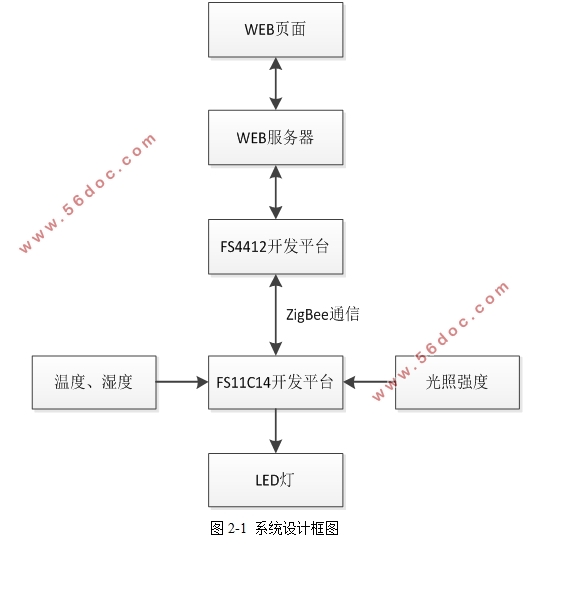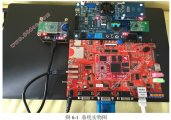基于ARM的智能家居系统设计
来源:56doc.com 资料编号:5D26673 资料等级:★★★★★ %E8%B5%84%E6%96%99%E7%BC%96%E5%8F%B7%EF%BC%9A5D26673
资料以网页介绍的为准,下载后不会有水印.资料仅供学习参考之用. 密 保 惠 帮助
资料介绍
基于ARM的智能家居系统设计(任务书,开题报告,论文12000字)
摘 要
智能家居系统是指通过搭建一个系统集控平台,利用综合布线技术、计算机通讯技术以及自动控制技术将家中的电器设备有机地结合在一起,实现各种家庭电器之间的互联互通,最终达到整体智能控制的目的。
本文是基于ARM平台的智能家居系统设计,并结合Linux系统和ZigBee无线技术实现家居的智能化管理。数据采集模块利用传感器采集温度、湿度和光照强度这三种环境信息,然后通过ZigBee技术将这些环境信息传送到数据处理模块,数据处理模块对这些环境信息进行判断和分析,最终会通过WEB服务器将这些信息实时反映到WEB页面上,并且用户可以在WEB页面上通过LED控制按钮对LED进行开关操作,从而使用户对家庭内部情况进行实时的掌握以及控制。
关键词:智能家居 ZigBee ARM Linux WEB服务器
The design of smart home system based on ARM
Abstract
Smart home system is that by building a system integrated control platform, the use of integrated wiring technology, computer communication technology and automatic control technology in the home electrical equipment organically unifies in together, to achieve interoperability between various types of household electrical appliances, and ultimately achieve overall intelligence control purposes.
This paper is based on the ARM platform of smart home system design, and combined with Linux system and ZigBee wireless technology to realize the intelligent management of home. Data acquisition module use sensors to collect the temperature, humidity and light intensity the three kinds of environmental information, and then through the ZigBee technology will be the environment information is transmitted to the data processing module, data processing module carries out judgment and analysis of these environmental information, will eventually these information in real time to reflect to the web page through the web server, and the user can in web pages through the LED control button LED switch operation, allowing the user to real time control and control the internal situation of the family.
Key Words: Smart Home; ZigBee; ARM; Linux; Web Server


目 录
摘要 I
ABSTRACT II
第一章 绪论 1
1.1 研究背景 1
1.2 当前研究状况 1
1.3 课题设计内容 2
第二章 智能家居系统的总体方案 3
2.1 系统的设计规划 3
2.2 系统总体方案设计 3
第三章 系统硬件设计 5
3.1 数据采集模块 5
3.1.1 温湿度传感器 7
3.1.2 光照传感器 8
3.2 数据处理模块 9
3.3 ZigBee通信模块 10
第四章 系统软件设计 12
4.1 Linux系统简介 12
4.2 系统开发平台搭建 13
4.2.1 Linux交叉编译环境的建立 13
4.2.2 Boot Loader 13
4.2.3 Linux内核的配置和编译 14
4.2.4 文件系统移植 15
4.3 数据采集端软件设计 15
4.3.1 温湿度模块软件设计 16
4.3.2 光照模块软件设计 17
4.4 数据处理中心软件设计 18
4.4.1 数据接收模块软件设计 18
4.4.2 数据分析模块软件设计 19
4.5 ZigBee通信模块软件设计 20
4.5.1 协调器节点软件设计 20
4.5.2 终端节点软件设计 21
第五章 嵌入式服务器的搭建 23
5.1 嵌入式服务器的工作原理 23
5.2 BOA服务器移植 25
第六章 系统测试 27
6.1 系统实物图 27
6.2 系统功能测试 27
结语 29
参考文献 30
致谢 32
|





